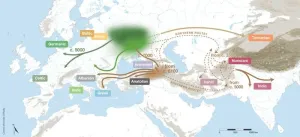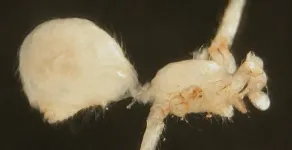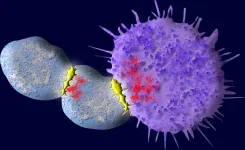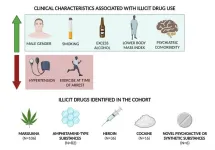New insights into the origin of the Indo-European languages
Linguistics and genetics combine to suggest a new hybrid hypothesis for the origin of the Indo-European languages
2023-07-27
(Press-News.org)
For over two hundred years, the origin of the Indo-European languages has been disputed. Two main theories have recently dominated this debate: the ‘Steppe’ hypothesis, which proposes an origin in the Pontic-Caspian Steppe around 6000 years ago, and the ‘Anatolian’ or ‘farming’ hypothesis, suggesting an older origin tied to early agriculture around 9000 years ago. Previous phylogenetic analyses of Indo-European languages have come to conflicting conclusions about the age of the family, due to the combined effects of inaccuracies and inconsistencies in the datasets they used and limitations in the way that phylogenetic methods analyzed ancient languages.
To solve these problems, researchers from the Department of Linguistic and Cultural Evolution at the Max Planck Institute for Evolutionary Anthropology assembled an international team of over 80 language specialists to construct a new dataset of core vocabulary from 161 Indo-European languages, including 52 ancient or historical languages. This more comprehensive and balanced sampling, combined with rigorous protocols for coding lexical data, rectified the problems in the datasets used by previous studies.
Indo-European estimated to be around 8100 years old
The team used recently developed ancestry-enabled Bayesian phylogenetic analysis to test whether ancient written languages, such as Classical Latin and Vedic Sanskrit, were the direct ancestors of modern Romance and Indic languages, respectively. Russell Gray, Head of the Department of Linguistic and Cultural Evolution and senior author of the study, emphasized the care they had taken to ensure that their inferences were robust. “Our chronology is robust across a wide range of alternative phylogenetic models and sensitivity analyses”, he stated. These analyses estimate the Indo-European family to be approximately 8100 years old, with five main branches already split off by around 7000 years ago.
These results are not entirely consistent with either the Steppe or the farming hypotheses. The first author of the study, Paul Heggarty, observed that “Recent ancient DNA data suggest that the Anatolian branch of Indo-European did not emerge from the Steppe, but from further south, in or near the northern arc of the Fertile Crescent — as the earliest source of the Indo-European family. Our language family tree topology, and our lineage split dates, point to other early branches that may also have spread directly from there, not through the Steppe.”
New insights from genetics and linguistics
The authors of the study therefore proposed a new hybrid hypothesis for the origin of the Indo-European languages, with an ultimate homeland south of the Caucasus and a subsequent branch northwards onto the Steppe, as a secondary homeland for some branches of Indo-European entering Europe with the later Yamnaya and Corded Ware-associated expansions. “Ancient DNA and language phylogenetics thus combine to suggest that the resolution to the 200-year-old Indo-European enigma lies in a hybrid of the farming and Steppe hypotheses”, remarked Gray.
Wolfgang Haak, a Group Leader in the Department of Archaeogenetics at the Max Planck Institute for Evolutionary Anthropology, summarizes the implications of the new study by stating, “Aside from a refined time estimate for the overall language tree, the tree topology and branching order are most critical for the alignment with key archaeological events and shifting ancestry patterns seen in the ancient human genome data. This is a huge step forward from the mutually exclusive, previous scenarios, towards a more plausible model that integrates archaeological, anthropological and genetic findings.”
END
[Attachments] See images for this press release:

ELSE PRESS RELEASES FROM THIS DATE:
2023-07-27
Some organisms, such as tardigrades, rotifers, and nematodes, can survive harsh conditions by entering a dormant state known as “cryptobiosis.” In 2018, researchers from the Institute of Physicochemical and Biological Problems in Soil Science RAS in Russia found two roundworms (nematode) species in the Siberian Permafrost. Radiocarbon dating indicated that the nematode individuals have remained in cryptobiosis since the late Pleistocene, about 46,000 years ago. Researchers from the Max Planck Institute of Molecular Cell Biology and Genetics (MPI-CBG) in ...
2023-07-27
PHILADELPHIA – A gene encoding a protein linked to tau production—tripartite motif protein 11 (TRIM11)—was found to suppress deterioration in small animal models of neurodegenerative diseases similar to Alzheimer’s disease (AD), while improving cognitive and motor abilities, according to new research from the Perelman School of Medicine at the University of Pennsylvania. Additionally, TRIM11 was identified as playing a key role in removing the protein tangles that cause neurodegenerative diseases, like AD. The findings are published today in Science. ...
2023-07-27
Cognitive and computer scientists at the University of Toronto, Universitat Pompeu Fabra and the Catalan Institution for Research and Advanced Studies have found child language development and the historical evolution of the world’s languages share a common cognitive foundation—a core knowledge base where patterns of children’s language innovation can predict patterns of language evolution, and vice versa.
Published today in Science, the paper is a first-of-its-kind step toward a unified theory of the lexicon and the mind examined across timescales. The result may also help predict how a word’s meaning may change ...
2023-07-27
People often debate whether social media creates "echo chambers" by showing users content that matches their politics and in turn increases polarization. A new study published today in the journal Nature reports that reducing Facebook users' exposure to content from politically "like-minded" sources had no measurable effect on their political beliefs or attitudes during the 2020 U.S. presidential election.
The findings are part of a broader research project examining the role of ...
2023-07-27
Australia’s rich and diverse fauna never fails to surprise us, as a new spider species has been documented from the continent.
The novel species, a blind daddy long-legs, was found in boreholes in the arid Pilbara of Western Australia. It is the first cave-adapted daddy long-legs spider reported from the continent, with other blind species of its genus so far only found in Thailand, Laos, and Vietnam.
“It represents a subfamily that was previously thought to be restricted to the tropical north and east of the continent,” says Bernhard Huber, one of the authors of a recent study published ...
2023-07-27
27 July 2023
Geological Society of America
Release No. 23-28
Contact: Justin Samuel
+1-303-357-1026
jsamuel@geosociety.org
Boulder, Colo., USA: GSA is pleased to welcome three exceptional new Fellows who will join us in our mission to advance geoscience knowledge and discovery through excellent writing, research, and advocacy.
GSA’s 2023–2024 Science Communication Fellow is Arianna Soldati.
Soldati is an assistant professor of volcanology at North Carolina State University. Her lab group works on a variety of topics, ranging from effusive eruptions to critical minerals. She received her Ph.D. in geological sciences from the University of ...
2023-07-27
New Haven, Conn. — In a promising form of immunotherapy known as CAR T-cell (chimeric antigen receptor) therapy, the patient’s T cells are engineered to better recognize and attack antigens on the surface of cancer cells. In treatments currently approved for use in battling lymphoma and leukemia, however, the therapy has a drawback: Amidst the cancer-killing frenzy, many engineered T cells become tainted with the remnants of cancer antigens, which causes them to turn on other T cells. This eventually depletes the body of cancer-fighting cells ...
2023-07-27
Digital Science, a technology company serving stakeholders across the research ecosystem, is pleased to announce that the Research Corporation for Science Advancement (RCSA) has chosen Symplectic Grant Tracker from Digital Science’s suite of flagship products to advance its aims of providing catalytic funding for innovative scientific research and the development of academic scientists.
RCSA joins the 50+ foundations, charities and funders worldwide who manage their end-to-end grant lifecycle using Symplectic Grant Tracker. Designed from the outset to meet research funding needs, Grant Tracker includes features to assist applicants, reviewers, committees and ...
2023-07-27
PHILADELPHIA (July 27, 2023) – Two decades ago, the Practice Environment Scale of the Nursing Work Index was published to measure the nursing practice environment. Although the instrument's use has resulted in advances in science and quality improvement efforts, its potential may be limited by the availability and quality of translations into different languages.
Researchers from the University of Pennsylvania School of Nursing (Penn Nursing) investigated published translations of the instrument and have identified ...
2023-07-27
Philadelphia, July 27, 2023 – Approximately one-third of young adults in Victoria, Australia, who experienced sudden cardiac deaths (SCDs) outside of a hospital setting from April 2019 to April 2021 used illegal drugs prior to their fatal events, reports a new study in Heart Rhythm, the official journal of the Heart Rhythm Society, the Cardiac Electrophysiology Society, and the Pediatric & Congenital Electrophysiology Society, published by Elsevier. The analysis of data on substance abuse, revealed through positive toxicology reports and patient histories and recorded in one of the world’s largest and most comprehensive SCD registries, ...
LAST 30 PRESS RELEASES:
[Press-News.org] New insights into the origin of the Indo-European languages
Linguistics and genetics combine to suggest a new hybrid hypothesis for the origin of the Indo-European languages







